#Hybrid Mahonia
Explore tagged Tumblr posts
Text

Mahonia x lindsayae 'Cantab' / 'Cantab' Fragrant Mahonia at the JC Raulston Arboretum at North Carolina State University in Raleigh, NC
#Mahonia x lindsayae 'Cantab'#Mahonia x lindsayae#Mahonia#Berberidaceae#Cantab fragrant mahonia#Fragrant Mahonia#Hybrid Mahonia#Lindsay's mahonia#Plants#Flowers#Nature photography#Photography#photographers on tumblr#Jc raulston arboretum#North Carolina State University#Ncsu#nc state#Raleigh#Raleigh NC#north carolina#🌺🌻
6 notes
·
View notes
Text

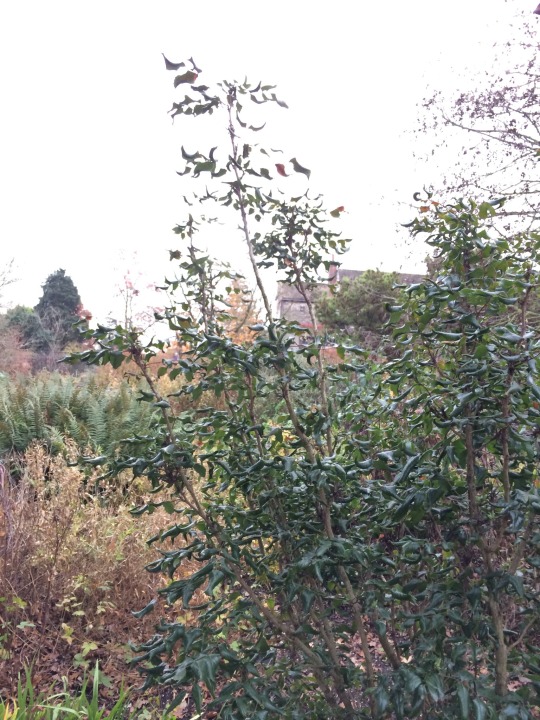
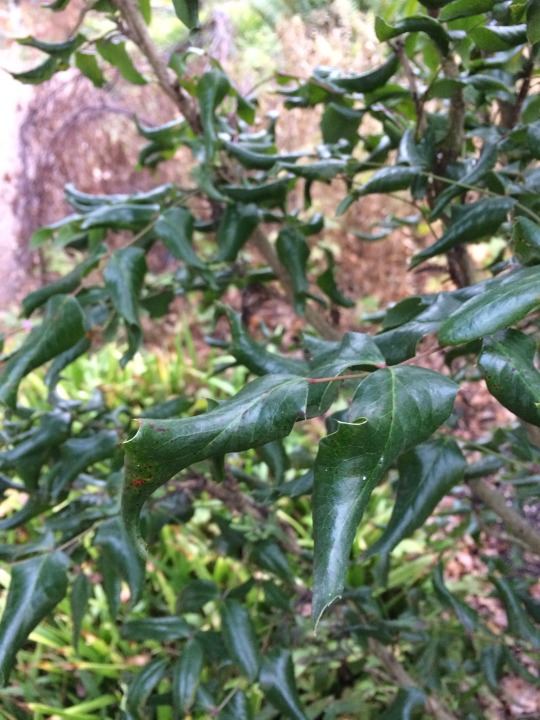
Plant of the Day
Sunday 25 February 2024
The evergreen shrub Mahonia × wagneri 'Undulata' (Oregon grape) is a hybrid of Mahonia aquifolium and Mahonia pinnata. It creates an upright shrub with wavy, glossy leaves. There are clusters of bright yellow flowers in spring.
Jill Raggett
48 notes
·
View notes
Text
My Garden Flowers Part 2
All photos mine. The narrow-leaved sundrops photo is edited for colour since the camera apparently can't reproduce that intense of a yellow. Neither can any Photopea editing, but at least it's closer. It's the bright of highlighter yellow but more golden.























In order of appearance:
031. Philadelphia fleabane (Erigeron philadelphicus) A welcome "weed" I couldn't find available at any of the native plant places in Ontario (one in Manitoba carried it but it wasn't available) but she planted herself.
032. Canadian Lettuce (Lactuca canadensis) Another welcome "weed" that sadly didn't manage to reseed, but maybe one will turn up again.
033-034. Jack-in-the-Pulpit male and female flowers (Arisaema triphyllum) The male has one leaf set while the female has two. The babies only have a leafset and no flowers for the first couple years of their lives. Then they reach sexual maturity as males, the next year they'll be female and switch back and forth until the end of their lives.
035. Early Meadow Rue (Thalictrum dioicum) Not pictured as she hasn't flowered yet. She's new. Hopefully next year.
036. Creeping Oregon Grape (Mahonia repens) First they gave me a non-native cinquefoil but thankfully rectified it by giving me two of these when I'd only ordered one. They've flowered before, but never so profusely as they both have this spring, and there are a number of berries ripening! They also made a baby from previous years, or else one of them suckered.
037. Three-Leaved Coneflower (Rudbeckia triloba) So...I planted her. She died. I swear she died, like root and all, she did not make the winter. Didn't come up in the spring. But now she is in several places! Managed to reseed herself? Perhaps. I don't recall that she flowered the year I planted her. Had dormant seeds in her pot with her? Coincidental present from squirrels? Either way, she's roughly in the spot I wanted her and is flowering well. Who cares how she got there?
038. Witherod Viburnum (Viburnum nudum cassinoides) Not pictured as she hasn't flowered yet. Hopefully next year!
039. Purple Milkweed (Asclepias purpurascens) Not pictured as she hasn't flowered yet. She's a new milkweed species for me! If she makes it through the summer and then the winter I should have more flowers to post in a year or two. :)
040. Rosy Pussytoes (Antennaria rosea) Not pictured as she hasn't flowered yet. Surviving, though, which is saying something because not even weeds grow there. It's a very dry spot and I've been kind of neutred from watering. But I read that she likes dry and that spot is dry. So good luck to her.
041. Prairie Alumroot (Heuchera richardsonii) Not pictured as she hasn't flowered yet. Also surviving in said very dry area.
042. Ramps (Allium tricoccum) I really hope her seeds made baby ramps! They only flower after reaching maturity at seven years, which is why it's bad when people come and uproot the lot of them. And I mean, they taste nice but not where I understand why people do that.
043. Spicebush (Lindera benzoin) My native allspice substitute! Her berries are currently developing and will be red in the fall. Still hoping to attract spicebush swallowtails one day.
044. Bigleaf Lupine (Lupinus polyphyllus) Was supposed to be sundial lupine but definitely isn't. There is disagreement between VASCAN and the USDA over whether there is a single variant of one subspecies of L. polyphyllus that's native to Ontario. This one stays in my garden until that's settled. Anyway, she's a gorgeous plant but the reason to avoid intentionally planting it in Ontario is that it easily hybridizes with sundial lupine. The hairstreak caterpillar can only eat true sundial lupine leaves. I don't know if the variant that the USDA says is native is a misidentified hybrid (bad, but also doesn't seem like it because the variant listed by the USDA is Lupinus polyphyllus ssp. polyphyllus var. polyphyllus) or just a well-behaved variant (fine, just like there's a native subspecies of Phragmites australis). But again, I'll be leaving mine in until I learn for sure, and I won't be planting sundial lupine there to avoid hybridization.
045. Sweet Joe-Pyeweed (Eupatorium purpureum) Fuzzy flowers! She can get very tall. I'm also finding out she's a slow spreader as there is an individual nearby that I didn't plant.
046. Tall Bluebells (Mertensia paniculata) She survived several years and seemed to do well, but she didn't come up this spring. I'll need to get another one and try a spot that's not quite so tough.
047. Poke Milkweed (Asclepias exaltata) Not pictured as she hasn't flowered yet. But this is her second year, so to judge by some of my other species she should do it next year!
048. Narrow-Leaved Sundrops (Oenothera fruticosa) No flowers I've seen are as intensely yellow as those in this genus, and narrow-leaved sundrops and evening primrose in particular seem to just glow.
049. Cup Plant (Silphium perfoliatum) The coolest part of this plant is in the name: the bases of her leaf stalks wrap around the flower stalk to make cups at the joints. Water settles there and birds come to drink. I haven't seen this happen yet, but I'm waiting. The flowers, however, are quite sizable, very pretty, and attract lots of bees. She gets tall like some common sunflower cultivars.
050. Canada Violet (Viola canadensis) She barely came back this year after doing well for several. I think it was just a dry winter, but the point is for them to be able to survive all seasons any year, so I'm going to try somewhere else.
051. Stinging Nettle (Urtica gracilis) I'm assuming, anyway. She planted herself in my garden at my former apartment and I potted and took her with me when I moved. She's been doing okay. And bitey. She's very bitey.
052. Zigzag Goldenrod (Solidago flexicaulis) I didn't plant that, so free native plant for me! She's also made babies.
053. Cutleaf Coneflower (Rudbeckia laciniata) Finally flowering this year!
054. Lowbush Blueberry (Vaccinium angustifolium) Not pictured as I haven't got pictures yet.
055. Highbush Blueberry (Vaccinium corymbosum) A cultivar, though I can't remember which. I try to avoid cultivars and get the wild type if I can, but it's not always possible and not all cultivars are bad.
056. Lance Selfheal (Prunella vulgaris lanceolata) Selfheal is a common garden weed but unobtrusive and makes cute purple flowers. Not to mention edible and medicinal uses! This one is the subspecies native to Ontario proper, whereas her close cousin is common up here but apparently only native to the northeastern United States bordering southern Ontario.
057. Dense Blazing Star (Liatris spicata) She's fuzzy. She's magenta purple. Bees love her. She's perfect.
058. Fairy Candle (Actaea racemosa) She's related to the baneberries and is herself poisonous but she does have some limited edible uses. And her delicate white flowerheads are lovely.
059. Star-Flowered Onion (Allium stellata) So glad I was able to get her before the place that sold her stopped shipping to my province. No one in my province carries this! But she is native, I have her, and she is an ever green plant that simply resumes growth as soon as the snow melts.
060. Wood Violet (Viola sororia) Other than V. odorata, which is invasive in North America, if you see the classic blue, purple, and white violets growing everywhere in the spring in North America it's probably this species. Yes, violets can actually be blue! Not the sky blue of forgetmenots, dayflowers, or bluebells, or the deep blue of lobelias, but blue.
#blackswallowtailbutterfly#my photos#photography#my garden#garden flowers#native plant gardening#native flowers of Carolinian Canada and USA#Erigeron philadelphicus#Lactuca canadensis#Arisaema triphyllum#Clinopodium vulgare#Mahonia repens#Rudbeckia triloba#Allium tricoccum#Lindera benzoin#Lupinus polyphyllus#Eupatorium purpureum#Mertensia paniculata#Oenothera fruticosa#Silphium perfoliatum#Viola canadensis#Urtica gracilis#Solidago flexicaulis#Rudbeckia laciniata#Vaccinium corymbosum#Prunella vulgaris lanceolata#Liatris spicata#Actaea racemosa#Allium stellata
11 notes
·
View notes
Text
Henry Mitchell on designing for low maintenance
In my recent post covering Henry Mitchell’s advice about lawns and alternatives thereto, I promised to next share his ideas on designing gardens for lower maintenance, also from The Essential Earthman starting at page 79. He introduces the topic: “The saving of time and labor in the garden is not important if you have an endless supply of both, but many gardeners find themselves unable to keep it all together, as you might say.”
So he has suggestions, especially for medium-sized gardens – up to 1/2 acre – where the gardener has to do it all him or herself. Because size matters: “In big gardens there simply has to be plenty of labor, and in tiny places, 30 by 30 feet, there’s not enough to do.” I’ve illustrated Mitchell with photos of home gardens I’ve visited.
Lawn Edging
“If there is lawn, do not let the grass run up to the edge of rose beds or any other place where hand-trimming will be necessary for a neat effect. Instead, let the lawn come up a grade-level band of stone or concrete so that on the last lap the mower rests partly on the lawn and partly on the stone.” This border is nicely defined, but the stones don’t make mowing easy.
Easier to mow along, though not quite what Mitchell had in mind.
Reduce Edging with Wide Borders
“Have as few edges to things as possible. Narrow beds have a disproportionate amount of edging; therefore a border 14 feet wide and 100 feet long (with stepping stones to get at things) is easier than a number of small beds separated by brick or grass paths.”
Probably too much edging maintenance for Mitchell.
Paths
“Have no more paths than truly necessary. One path, six feet wide, is best. If it is brick, it should be set in mortar. If it is flagstone, it should be set in mortar. The inexperienced person has no conception at all how many hours can be spent weeding pavement that is not set in concrete and grouted with mortar.
“And while on this subject, take pains with the color of the mortar. White mortar between brick, fieldstone, slate and so on looks awful…. Gravel is absurd. It rarely looks good, is never comfortable, and is ideal for weeds and masochists.”
I bet we can all agree that weeding between pavers is a slog! Also, gravel IS absurd!
Gravel can look pretty cool, but low-maintenance it’s not.
Rock Gardens
“Avoid intensive care projects. Nothing known to man equals a rock garden for labor. Incredibly enough, I have twice seen rock gardens advocated as labor-saving devices, but this only proves that human perversity is boundless. Nothing in all gardening requires so much work for so little return as a rock garden. If the gardener wants lewisias and saxifrages and other rock plants, he should struggle with them in tubs or raised borders, not in a rock garden.”
I love “human perversity is boundless.”
Greenhouses
“Greenhouses may be nice (usually they are a total mess) but the labor of keeping them is substantial….[examples given]. A greenhouse can be endlessly rewarding, but the gardener should be certain he really wants one, and if he really does, then it should be as large as possible, not as small as possible.”
The Right Plants
“Avoid plants that necessarily involve many hours’ labor a year. Irises and roses, to name two, must be hand-weeded and sprayed.
“Wide borders with shrubs (smoke bushes, fringe trees, small plums, pink locusts, mahonias, nandinas, photinias, small junipers or yews or box, hybrid rugosa roses, Japanese maples, azaleas, blueberries, viburnums) and clumps of bulbs like daffodils and tulips; perennials like peonies, Japanese anemonies, baptisias, artemisias, poppies, and so on and on, are less work than borders of annuals or borders of those numerous perennials that must be staked, lifted, replanted every year or two. Hostas, yuccas, and wormwoods of various sorts are also superb, trouble-free creatures. Before planting anything, ask yourself if you will need to stake it, tie it, prune it, spray it, and weigh its beauty against your real commitment to it. Often, one would really prefer peonies.”
It’s interesting to see which shrubs and perennials he recommended (published in 1982), especially citing peonies as low-maintenance. Did he never have to stake his?
Who thinks these peony-packed borders are low maintenance?
Good Foliage
“Gravitate always to plants that have good foliage when not in bloom. Irises, for example, have terrible foliage in summer. The handsomer the foliage of a plant, the less work in making the garden look good.”
Good tip!
Lily Ponds. Really?
“Consider a water lily pool as large as possible. Dollar for dollar and hour for hour of maintenance, the garden lily pool is the best investment of all. But never start such projects without reading books…”
Okay, but suggesting any pond as a low-maintenance design feature seems crazy to me.
rchitecture, especially Benches
“The smaller the garden and the less labor available, the more important the architecture, like a wood bench of first-rate honesty and solidity…A good place to sit in the garden is worth having, and it will count strongly in the design, far more than the frumpy ornaments sometimes acquired.” Agree!
Shapes and Colors
“Keep all outlines bold, over-scaled, plain, rectangular, and keep to gray, black, earth color, except in chairs, if you like to spend 50 hours a year painting them. White leaps out in the garden, but if you like the effect (and in other people’s gardens it can look great) of white fences, white furniture, be prepared to paint.”
I agree with “bold, over-scaled and plain” but rectangular, instead of curves?
An example of straight lines and rectangular shapes in a San Francisco garden. Not great for mowing, and to my eyes, a distraction.
That’s better.
Henry Mitchell on designing for low maintenance originally appeared on GardenRant on September 1, 2023.
The post Henry Mitchell on designing for low maintenance appeared first on GardenRant.
Read More
0 notes
Text
Alrighty friends,
I’m about to make a Big Herb Purchase. like huge. I’ve emptied my cabinet of everything over a couple years old, and now i need to reup on basically everything bc I’ve been out of lots of things for forever.
This is everything that will be purchased..hopefully..if i can afford it.
Why do i share this with you? Well, a restocked herbal cabinet for me, means magical powders, teas. tinctures, salves and more for you!
What I would love is for anyone who’s been looking for any sort of herbal products to get some requests going for what I can be whipping up as soon as these get delivered. Having some pre-orders or commissions for specific products going into this big order would feel great, rather than placing an order with my only plan being study and personal/family use! *edit* a request doesn’t make you obligated to order! I just like ideas! 😁
I wont write out my own correspondences for each here, but if you have any questions about an herb on the list, or if you have a correspondence/spell/working in mind, I can help choose herbs that would suit you. I also have all the herbs from my garden this year, so this isn't a complete list of what will be available! List under the cut!
Ashwaghanda, Withania somnifera
Astragalus, Astragalus propinquus
Burdock, Arcticum lappa
California Poppy, Eschscholzia californica
Catnip, Nepta cataria
Chapparral, Larrea tridentata
Cleavers, Galium aparine
Dandelion, Taraxacum officinale
Echinacea, Echinacea purpurea
Elder Berry and Flower, Sambucus nigra
Goldenseal (if I can find a sustainable supplier) Hydrastis canadensis
Hawthorn Berry and Leaf/Flower, Crataegus
Hibiscus, Hibiscus sabdariffa
Hops Humulus lupulus
Lavender, hybrid of Lavendula augustifolia and L. latifolia
Lobelia, Lobelia erinua
Marshmallow, Althea officinalis
Mugwort, Artemisia vulgaris
Oatstraw, Avena Sativa
Oregon Grape, Mahonia aquifolium
Passionflower, Passiflora incarnata
Plantain, Plantago major
Red Clover, Trifolium pratense
Rosehips, Rosa canina
Sarsaprilla, Smilax ornata
Skullcap, Scutellaria lateriflora
Slippery Elm (if I can find a sustainable supplier) Ulmus rubra
St. John's Wort, Hypericum perforatum
Turmeric, Curcuma longa
Usnea, Usnea barbata
Valerian, Valeriana officinalis
Wild Cherry, Prunus avium
Wood Betony, Betonica officinalis
Wormwood, Artemisia absinthium
Yarrow, Achilea millefolium
Yellow Dock, Rumex crispus
#herbs#greenwitch#herb cabinet#green witch#green magic#herb witch#magic#witch#witchy#witchcraft#herbalist#herbalism#folk herbalist
72 notes
·
View notes
Photo

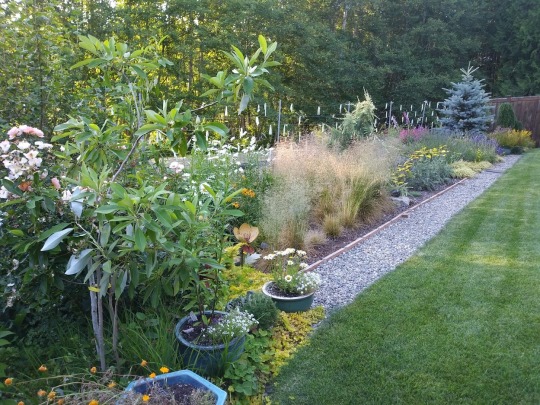
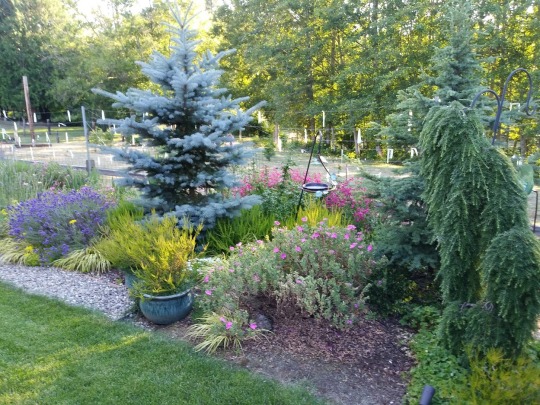
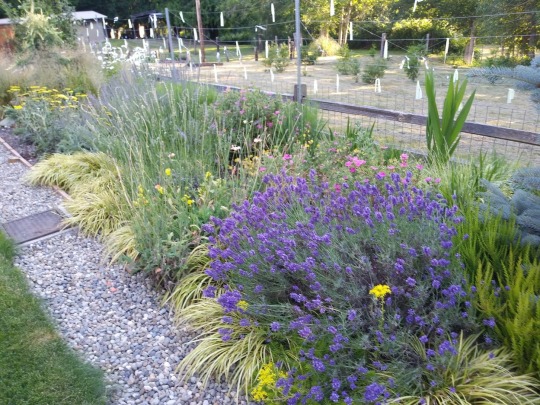
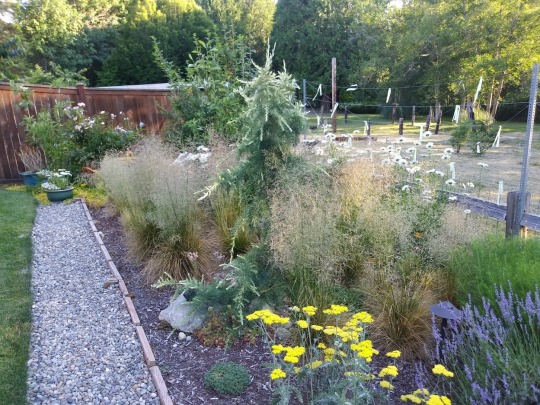

Our BACK Garden - many photos have been posted featuring the small Flower Garden on the south side of the house. This posting is for the entire BACK Garden, just an overview.
1. The back of our house, which faces due west. Photo taken last evening from the Upper Meadow part of our neighborhood forest restoration project. That’s the Back Porch up above, beneath which is a bench seat, shade garden, and a bunch of pots. On the right up against the wall is the Flower Garden. And, in front, behind the split-rail fence that separates all our homes from the forest project, is the “Back Garden”.
2. Overall view of the Back Garden, 60′ x 10-12′ extending south to north along the west side of the lot. That’s a gravel Infiltration Trench along the inner side, which collects rainwater from the roof and allows it to soak into the groundwater table. The CONCEPT of the Back Garden was developed by both of us, working together for a change, just as we did with the Japanesque Front Garden. The idea was to create a garden that related to the meadow beyond the fence, but that could also house a number of larger plants we brought from our former home in Bothell, WA. So it starts at one end with a riparian zone, spreads into a prairie, that interblends with Mediterranean plants, and ends in an alpine zone.
UPPER - the “Alpine” features a smaller-growing Baker’s Colorado blue spruce (Picea pungens ‘Bakeri’), a light green Mountain hemlock (Tsuga mertensiana), and an upright-trained ‘Thorson’s Weeping’ Western hemlock (Tsuga heterophylla cultivar). There are also shrubs: colorful-foliaged summer heathers (mainly Calluna vulgaris ‘Firefly’), a rockrose, several smaller growing forms of mahonia, a Himalayan blueberry, a Crandall currant (fragrant, yellow-flowered hybrid of the Intermountain West native Ribes odorata), HUGE bushy hybrid penstemon - Garnet and Firebird, and underneath the hemlocks - the tall ground-cover Big Sur manzanita (form of Arctostaphylos edmundsii).
UPPER MIDDLE - the “Mediterranean” features magenta-flowered Sunset rockroses (Cistus x pulverulentus), various English and French lavenders, a mass of chrome yellow Moonshine yarrow, and a mass of variegated purple moor grass (Molina caerulea ‘Variegata’) interplanted with various crocosmias.
MIDDLE - the “Prairie” - this is the largest part of the garden, melding into the Mediterranean garden on the north. This features double curving bands of Rudbeckia fulgida ‘Early Bird Gold’ and Becky Shasta Daisy, clumps of standard purple moor grass, white yarrow, purple Verbena bonariensis, Russian sage (Perovskia atriplicifolia), a whale-shaped mass of variegated Northern hairgrass (Deschampsia caespitosa), blending into a mass of billowing Arkansas blustar (Amsonia hubrechtii). And...at the juncture with the Mediterranean garden is a “weeping” Deodar cedar, probably Snow Sprite, planted in a mound of rocks with penstemon, sedums, and sempervivums.
Interesting story here - this was originally an upright “tree”, planted on the hill above our Bothell house. One summer the top was whacked off during routine blackberry and Scotch broom control. But one horizontal branch was left. So, in 2018, I dug it up and brought it with us, intending it to be an interesting “bonsai” in the garden. Well, the plant had other ideas. In 2019, the horizontal branch started to rise skyward - that’s right - during the summer of 2019, we watched as it went from horizontal to diagonal 45 degree angle. By 2020, that horizontal branch cranked itself to a 90 degree angle and had become a tree trunk, pointing directly up. SHOCKED!
SOUTH END - the “Riparian Zone” - shown partially in the Overall and view of the prairie. This features a blue hydrangea, grown from a shoot off a hydrangea in our very first garden in Atlanta in 1995, an big bushy Amber Flower Carpet rose, a volunteer native pink-flowering currant (the BIG bush - Ribes sanguineum), a pair of evergreen, upright, willowy, multi-stem Sweetbay magnolias - (Magnolia virginiana Jim Wilson MOONGLOW), a native evergreen huckleberry (Vaccinium ovatum), and an assortment of perennials, including: Jupiter’s Beard (Centranthus ruber), Baptisia, foxgloves, various different crocosmias, Salvia nemerosa, and Geum x Tangerine.
Well that���s the Intro folks - I will feature each of the plants over the next couple of years. Cheers on this 245th anniversary of the independence of the USA, as it became known.
3 notes
·
View notes
Photo







Plant of the Week: Hellebores
Although the doubles are all bought plants, the others are self sown and from happy hybrids that pop up all over the garden. I nipped out just before the storm (Eunice) hit us here in Lymington and now everything is being battered. Most things should stand Ok but I worry about nearby trees.
The Mahonia is just coming out. This is a short variety but still has to be cut back every so often. Bees love it, but they are sensibly hunkered down until things quieten.. At last we have a small clump of frogspawn in the pond. I thought that we would miss out again, I just hope that we get tadpoles to follow as last year none appeared.
While writing this, our lollipop bay tree, grown over the last fifteen years, blew over smashing the large terracotta pot it was planted in. An expensive pot now only useable as crocks for planting out other things. Hey Ho!
0 notes
Photo

This tough, evergreen shrub makes a superb screening plant, for it grows in almost any position - from full sun to shade and in most soils - and it gets to a considerable size. Its parents are the Chinese Osmanthus delavayi and thus the Turkish/Georgian Osmanthus decorus, which adds increased toughness to a stunning Asian shrub. Its leaves are 1 to 2 inches long, midgreen and leathery. Its fragrant, white, tubular flowers open in April. Its flowers aren't as clear a white nor as fragrant as those of O. delavayi, so relying on your garden's needs, that species could even be a much better choice. On the other hand, Osmanthus x burkwoodii features a robust enough constitution and massive enough stature to support a clematis to feature summer excitement. The GPP shrub folks suggest 'Duchess of Albany' or 'Etoile Violette'. This shrub combines with others with larger leaves, like rhododendrons and Mahonia. This hybrid was raised in England.
0 notes
Text
Jacques Piquée : Le mahonia hybride

Le mahonia hybride (Mahonia x media) de la famille des berbéridacées Décembre est le début de la morte saison et bien rares sont les plantes indigènes qui s’épanouissent encore à cette période un peu triste. Il faut donc chercher dans la flore exotique pour trouver des espèces qui fleurissent au cœur de l’hiver et qui permettent aux butineuses de trouver quelques gouttes de nectar et quelques…
View On WordPress
1 note
·
View note
Text
Le mahonia hybride (Mahonia x media) de la famille des berbéridacées
Décembre est le début de la morte saison et bien rares sont les plantes indigènes qui s’épanouissent encore à cette période un peu triste. Il faut donc chercher dans la flore exotique pour trouver des espèces qui fleurissent au cœur de l’hiver et qui permettent aux butineuses de trouver quelques gouttes de nectar et quelques grains de pollen lors de leurs sorties périodiques mais salutaires.
Certains mahonias asiatiques sont de celles-là et en particulier leur principal hybride qui associe les avantages de ses deux géniteurs, Mahonia japonica et Mahonia lomariifolia.
Il s’agit d’arbustes aux feuilles persistantes, composées de nombreuses folioles coriaces et épineuses qui évoquent un peu les feuilles du houx. Comme la plupart des espèces à floraison hivernale, ils ont opté pour la stratégie de fleurs voyantes et parfumées pour attirer les très rares pollinisateurs. Tous sont à floraison jaune lumineux et à odeur capiteuse.
Étymologie
Le genre Mahonia est dédié à un botaniste horticulteur américain d’origine irlandaise, Bernard Mac Mahon. Le signe x placé devant le nom spécifique indique qu’il s’agit d’un croisement entre deux espèces (hybride interspécifique), notion reprise par le nom media qui signifie intermédiaire.
Il a été obtenu en Angleterre dans les jardins de Windsor en 1955. Il s’agit donc d’une espèce artificielle qui n’existe pas dans la nature.
Le nom spécifique japonica de son premier parent est facile à traduire et il précise son origine géographique. Quant à la dénomination lomariifolia de son deuxième parent, elle signifie à feuilles de lomaria, espèce de fougère au feuillage très découpé. Actuellement, cette fougère appartient au genre Blechnum.
Description
Le mahonia intermédiaire est un arbuste d’environ 1,80 m au port raide et compact. Il pousse dans tous les sols suffisamment frais mais sans excès d’humidité, en plein soleil ou de préférence à mi-ombre dans les régions à été chaud.
Les feuilles composées imparipennées présentent de nombreux rangs de folioles épineuses qui impliquent l’utilisation de gants résistants lorsqu’on veut intervenir de quelque manière que ce soit pour entretenir la plante et notamment lorsqu’on souhaite la tailler après la floraison. A la suite d’un stress hydrique estival ou sous l’action du froid hivernal, ces feuilles virent au rouge intense.
Durant l’été, les pousses de l’année se terminent par un gros bourgeon florifère. Il éclate littéralement au début de l’automne et libère de nombreuses grappes terminales visibles dès le mois d’octobre. Elles s’épanouissent de fin novembre à courant janvier en fonction des conditions météorologiques et exhalent une agréable odeur de muguet. Les espèces types donnent des fruits bleu pruineux comestibles uniquement lorsqu’ils sont cuits. Consommés crus, ils peuvent déclencher des troubles intestinaux car ils contiennent plusieurs alcaloïdes.
Le mahonia hybride a engendré de nombreux cultivars comme ‘Charity’ et ‘Winter Sun’, qui comptent parmi les plus intéressants.
Le saviez-vous ?
Le genre Mahonia englobe des espèces d’origine asiatique à floraison hivernale mais aussi des espèces nord américaines à floraison printanière. Une des plus communes est le mahonia à feuilles de houx (Mahonia aquifolium ) espèce mellifère appelée également vigne de l’Oregon. Faute demieux, les pionniers utilisaient ses nombreux fruits pour préparer une boisson succédanée du vin !
On peut également en faire des gelées qui évoquent celles obtenues avec le cassis. Le genre Mahonia est très proche du genre Berberis (épine-vinette). Il existe d’ailleurs un hybride intergénérique dénommé x Mahoberberis aux caractères intermédiaires.
Index des articles sur les plantes mellifères
Cultiver des plantes mellifères en ville et au jardin Paru en janvier 2016
Qui est Jacques Piquée
Pour contacter Jacques Piquée utiliser le formulaire ci-dessous [contact-form-7 id=”3465″ title=”Jacques Piquee”]
Jacques Piquée : Le mahonia hybride Le mahonia hybride (Mahonia x media) de la famille des berbéridacées Décembre est le début de la morte saison et bien rares sont les plantes indigènes qui s’épanouissent encore à cette période un peu triste.
1 note
·
View note
Text

Berberis x hybridus / Hybrid Mahonia at the Sarah P. Duke Gardens at Duke University in Durham, NC
#Berberis x hybridus#Berberis#Hybrid Mahonia#Mahonia#Flowers#Foliage#Nature photography#photographers on tumblr#Sarah P. Duke Gardens#Duke Gardens#Duke University#Durham#Durham NC#North Carolina
0 notes
Text



Plant of the Day
Saturday 21 December 2019
On a winter walk recently I was delighted to find the fragrant, showy winter flowers of Mahonia × media 'Charity' (Oregon grape) greeting me over this garden wall! The flowers are produced in late autumn and winter. This upright, evergreen shrub is an interspecific hybrid between Mahonia oiwakensis subsp. lomariifolia and Mahonia japonica. It is a vigorous plant and grows well in moist but well-drained soil, in partial shade.
Jill Raggett
#mahonia#Oregongrape#evergreenshrub#interspecifichybrid#hybrid#yellowflowers#fragrant#shrub#wall#gardenwall#gateway#gate#hardy#winterinterest#wintergarden#horticulture#wsd#writtledesign#mhort
48 notes
·
View notes
Photo


Famille: BERBERIDACEAE
Genre: Mahonia
Espèce: hybride
Cultivar: ‘Charity’
Nom français: mahonia charity
Multiplication: Semis / Bouturage de tête
(Plantes hivernales)
0 notes
Text
Gartenbau 101: Witch Hazel has been published on Dekor Mobel
New Post has been published on http://neukreativmobel.com/gartenbau-101-witch-hazel/
Gartenbau 101: Witch Hazel
Zaubernuss, Hamamelis: „Wunderheiler“
Hamamelis hat Duft, sowie der Verhaftung sieht. In den dunkelsten Monaten des Winters, die Farben und würzigen Duft konnte nicht mehr wünschenswert, und ein Zweig drinnen gebracht ist die einfachste Art der Anordnung. Es ist ein Geheimnis dann, dass die Hexe Haselnüsse werden vor allem geschätzt von winter-Garten-Liebhaber. Sie brauchen nur ein wenig Geduld, und einige winter chill, genießen Sie die spinnenartigen Magie.
Photography by Britt Willoughby Dyer.
Oben: Das Wort „Hexe“ in die Falle der Hexe hazel ist eine Anspielung auf die alten englischen Wort für biegsame oder biegsam. Es passiert einfach zu haben eine überschreitene ähnlichkeit zu hazel.
Die wilde Hexe hazel in den Vereinigten Staaten gefunden wird, wird Hamamelis virginiana, hat Blumen, die sind nicht Auffällig, aber der Duft macht sich selbst bekannt, in Wald-Lichtungen. Seine Blätter, stengel, Rinde und Holz wurden eingekocht, die von Native Americans und destilliert als „Magisches Wasser“ und das wissen um seine heilenden Kräfte ging auf die ersten Siedler.
Oben: Hamamelis x intermedia ‚Arnold Promise‘ hat leuchtende Blüten, Duft, und gute herbstlaub.
Wachsende Hexe Haselnüsse in den Töpfen steigert Ihre Möglichkeiten in einem kleineren Garten: beleuchtete Blumen im winter, von einem Fenster, können gerollt werden, um zu einer weniger auffälligen Stelle im Sommer (aber halten Sie den Topf feucht). Sie brauchen Sonne für gute Blüte.
Cheat Sheet
Die besten Blumen-Farben kommen aus Sorten der hybrid – Hamamelis x intermedia.
herbstlaub ist eine Attraktion, die gezüchtet wird in neueren Hybriden, bringen Farbe in den Herbst, die ist fast so dramatisch wie die Blumen, die Folgen. ‚Jelena‘ ist einer von diesen; schauen Sie aus auch für ‚Vesna‘, ‚Frederic‘ und ‚Diane‘.
Hamamelis ist ein großer Strauch kann zu einem kleinen Baum. Wie hazel (keine Beziehung), kann es in Schach gehalten, durch die Beschneidung.
Lebendig zu Halten
Blumen-Produktion ist immun gegen Kälte, sondern Pflanzen brauchen Sonne geschützt. Wind kann tödlich sein; jedenfalls wird es tragen Weg, der Duft. Hardy Zonen 5-8.
Gute Erde Feuchtigkeit, im Sommer ist wichtiger als die Säure (im Allgemeinen bevorzugt Neutrale bis saure). Jedoch, Hamamelis mag es nicht zu Staunässe und benötigt eine gute drainage. Erhaltung der Feuchtigkeit durch Mulchen.
Seien Sie geduldig: die Hexe Haselnüsse nehmen eine Weile, um sich einzuleben und wachsen nicht viel für die ersten paar Jahre. Erwarten 10 Meter oder etwas mehr, nach 10 bis 20 Jahren.
Oben: Beste Hexe Haselnüsse für Farbe: Gelbes Leuchten am besten in der Dunkelheit, aber wenn Sie Hamamelis wo es hinterleuchtet werden in der niedrigen Sonne, burnt orange und intensives rot sind spektakulär. Gelb: ‚Pallida‘, ‚Barnstedt Gold‘, ‚Jermyn‘ s Gold‘. Orangen: ‚Aphrodite‘, ‚Vesna‘, ‚Lebkuchen‘. Beste Rotweine: ‚Diane‘, ‚Livia‘.
Oben: Die besten Düfte kommen aus Sorten der chinesischen Zaubernuss, Hamamelis mollis; suchen Sie nach ‚Boskoop‘ und ‚Jermyn‘ s Gold‘. Von den Hybriden, wählen Sie aus duftenden ‚Aphrodite‘ (orange-rot), ‚Aurora‘ (gold-orange) und ‚Arnold Promise‘ (siehe Abbildung).
Oben: Hamamelis x intermedia ‚Jelena‘. Wie Blätter im Herbst fallen, die Knospen deutlicher geworden, wie bereiten Sie für Zaubernuss ‚ s glory time: deep winter.
weitere Sträucher zu fügen Sie Interesse an einem Wintergarten, finden Sie Gartenbau 101: Mahonia.
ENTDECKEN Sie MEHR:
Frage 7 : Die Als Garten, &Pflanzen amp; Samen, Duft, Gartenarbeit 101, Orange, Pflanzen-Guides, Strauch, Sträucher, Winter, Hexe Haselnüsse, Gelb
0 notes
Text

Berberis x hortensis 'Underway' / 'Underway' Hybrid Mahonia at the Sarah P. Duke Gardens at Duke University in Durham, NC
#Berberis x hortensis#Berberis#Berberis x hortensis 'Underway'#Mahonia x media 'Underway#Mahonia x media#mahonia#Underway hybrid mahonia#Flowers#Nature photography#photographers on tumblr#Sarah P. Duke Gardens#Duke Gardens#Duke University#Durham#Durham NC#North Carolina
1 note
·
View note
Text



Plant of the Day
Thursday 26 November 2020
This burst of yellow flowers from Mahonia × media 'Winter Sun' was visible from a distance tempting visitors into the Winter Garden of Cambridge Botanic Garden, UK. This evergreen shrub is an interspecific hybrid of Mahonia lomariifolia and Mahonia japonica and has more compact growth than other plants resulting from this cross such as Mahonia × media 'Charity'.
Jill Raggett
#mahonia#yellowflowers#evergreenshrub#evergreen#plants#winterinterest#wintergarden#winterflowering#writtledesign#mhort#gardens#horticulture#garden#botanicgarden#botanic#cambridgebotanicgarden#cambridge
77 notes
·
View notes